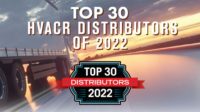Despite ongoing turmoil in the economy, much of it linked to the continuing coronavirus pandemic, analysts see upsides for the HVAC sector in 2022.
They also see challenges to be met, and developments that will impact the industry this year and well beyond.
Increasing interest in high-efficiency HVAC equipment and smart buildings; greater attention to indoor air quality (IAQ) as people battle the SARS-CoV-2 virus in homes, workplaces, and commercial spaces; and a boom in home-improvement and remodeling activity in general translate into opportunities for those in HVAC, industry-watchers say.
But, they warn, inflation, market trends, parts and equipment shortages caused by worldwide supply-chain problems, and a shortage of qualified workers in HVAC are roadblocks that people in the business have to overcome as they take up those opportunities.
Team leader of market intelligence
HARDI
“In general, it’s a mixed bag,” said Tim Fisher, team leader of market intelligence at Heating Air-Conditioning and Refrigeration Distributors International (HARDI), a trade organization for HVACR wholesalers. “On a dollar basis, we’re absolutely anticipating continued top-line growth. The issue here, though, will be inflated costs and slowing demand.”
Broadly speaking, Fisher said, demand on the residential side is expected to flatten, though that should be offset by growth in commercial demand. The exact market scenarios, he added, will vary from region to region.
Matt Michel, president of Service Nation Inc., a coalition of contractors in several trades who share best practices, sees choppy waters ahead in parts of HVAC. For example, historical patterns suggest that shipments of replacement central air systems and air-source heat pumps are due for a 40% falloff beginning later this year or in 2023, he said.
Replacements are generally on a 15-year cycle, he said, and a record number of units — more than 9 million — were shipped in 2020. The previous peak was 2005's 8.6 million units; in 2009, only 5.2 million units were shipped. (The 15-year downturn was delayed in 2020 and 2021, he said, due to replacements that had been deferred, many due to the pandemic.)
“Contractors have to get aggressive in their marketing and take their share from their more cautious competitors or it will be a tough few years,” Michel said. A decade of increasing demand, however, should follow the downturn, he said.
Here are more trends that Fisher, Michel, and others say will affect the HVAC economy in 2022, along with tips for taking advantage of them or, at the very least, weathering them:
• Supply-chain disruptions: They'll continue. “You can't sell what you don't have,” said Michel.
“Hopefully, this has served as a wake-up call for the industry, where offshore manufacturing might be brought back to North America, if not the United States,” he continued. “This won’t help short-term, but is ultimately healthier for the industry.” Fisher said Mexico is primed to benefit should HVAC manufacturing return to North America.
Dan Street, CEO of Scorpion, which provides technology and marketing services to local businesses, said HVAC businesses should, if able, stockpile parts and commonly used equipment as insurance against inflation and breaks in the supply chain.
“Local service providers continue to have more work than they’ve ever had before,” said Street. “But they know in the Yelp era if they don’t have the necessary materials to complete a job, not only do they lose the business, their brand takes a hit.”
• Inflation will remain a factor.
Many HVAC-related companies have announced price increases for 2022; Danielle Putnam, president of the New Flat Rate, which provides software tools for a variety of trades contractors, said “we have had to maintain a constant eye on the pricing of materials” and have been making more price updates than ever.
Street said inflation will prompt more consumers to attempt do-it-yourself home projects. “Get ready for DIY on steroids,” he said.
But HVAC can turn rising costs to its advantage, Michel said, when consumers, reacting to “utility bill sticker shock,” choose the highest-efficiency products available, resulting in accelerated equipment replacement.
• There will (still) be labor shortages.
“Staffing is going to be an issue for the foreseeable future in HVAC and really, every industry,” said Michel. “Contractors need to get better at growing their own technicians.”
Fortunately, Michel added, there are more programs than ever to train future technicians, though follow-up training and mentoring by senior technicians will be crucial. “If there was ever a time when teamwork is needed in contracting, it is the current environment,” he said.
• Smart HVAC technology is here to stay.
HVAC professionals should embrace it and get to understand it better, Putnam said, by installing it in their own homes. “The world is only going to keep getting 'smarter,' so find a way to be on the front of the curve instead of the back,” she said.
A time of uncertainty, Michel said, is a time to get aggressive in business. If the economy creates a headwind, he said, overcome it by working that much harder.
“Tough economic times are where the faint of heart fade away, while the bold make tremendous leaps forward,” said Michel.
Contractors, he added, should not go it alone, but should join an alliance that fits the budget and culture of their business.
“You will learn about changes sooner. You will learn about strategies and tactics for responding to the changing environment faster,” said Michel. “It can be the difference between success and failure.”








